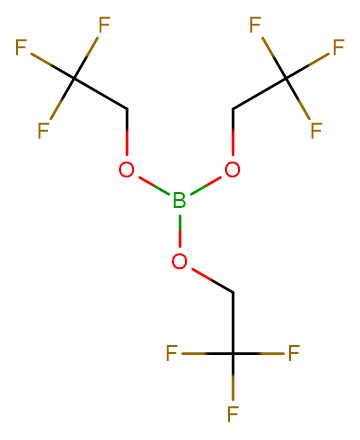
Tris(2,2,2-trifluoroethyl) borate
CAS No. 659-18-7
Tris(2,2,2-trifluoroethyl) borate( —— )
Catalog No. M15508 CAS No. 659-18-7
Tris(2,2,2-trifluoroethyl) borate is mostly used in condensation reactions.
Purity : >98% (HPLC)
 COA
COA
 Datasheet
Datasheet
 HNMR
HNMR
 HPLC
HPLC
 MSDS
MSDS
 Handing Instructions
Handing Instructions
| Size | Price / USD | Stock | Quantity |
| 5MG | 45 | In Stock |


|
| 10MG | 54 | In Stock |


|
| 25MG | 99 | In Stock |


|
| 50MG | 174 | In Stock |


|
| 100MG | 302 | In Stock |


|
| 200MG | Get Quote | In Stock |


|
| 500MG | Get Quote | In Stock |


|
| 1G | Get Quote | In Stock |


|
Biological Information
-
Product NameTris(2,2,2-trifluoroethyl) borate
-
NoteResearch use only, not for human use.
-
Brief DescriptionTris(2,2,2-trifluoroethyl) borate is mostly used in condensation reactions.
-
DescriptionTris(2,2,2-trifluoroethyl) borate is mostly used in condensation reactions. It has been shown to promote the direct formation of amides from carboxylic acids and amines as well as the formation of imines from amines or amides with carbonyl compounds.
-
In Vitro——
-
In Vivo——
-
Synonyms——
-
PathwayOthers
-
TargetOther Targets
-
RecptorOthers
-
Research Area——
-
Indication——
Chemical Information
-
CAS Number659-18-7
-
Formula Weight307.91
-
Molecular FormulaC6H6BF9O3
-
Purity>98% (HPLC)
-
SolubilityDMSO: > 11 mM
-
SMILESFC(F)(F)COB(OCC(F)(F)F)OCC(F)(F)F
-
Chemical Name——
Shipping & Storage Information
-
Storage(-20℃)
-
ShippingWith Ice Pack
-
Stability≥ 2 years
Reference
1.Rait JL. Aust N Z J Ophthalmol. 1999, 27(1):57-64.
molnova catalog



related products
-
AM966
AM966, a excellent affinity, specific, oral LPA1(IC50=17 nM) antagonist, suppresses LPA-stimulated intracellular calcium release.
-
Gamma-Methylleucine
Gamma-Methylleucine is an auxiliary for copper-catalyzed asymmetric Michael reactions.
-
Sugammadex (sodium)
Sugammadex a synthetic derivative of γ-cyclodextrin is a steroid-based neuromuscular blocker reversing agent.



 Cart
Cart
 sales@molnova.com
sales@molnova.com


